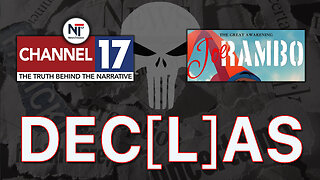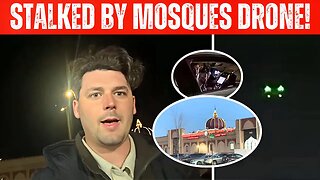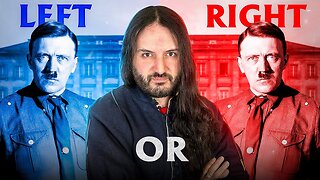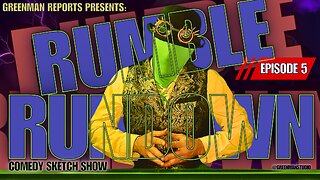Premium Only Content

Plot To Overthrow Christmas 1944
Christmas, celebrated by most Christians on December 25, commemorates the birth of Jesus of Nazareth. Americans, like many of the world’s peoples, have developed their own Christmas traditions and observances, and these have changed greatly over time.
Today, most Americans blend religious and secular customs with their own family traditions, often incorporating food, decorations and rituals from places they or their ancestors once called home. Roast turkey and ham are popular for Christmas dinner throughout the country, but depending on the region, so are tamales, roast goose with red cabbage, crawfish jambalaya, roast pork or “seven fishes” seafood salad.
In the Southwest, luminarias — lanterns made from brown paper bags weighted down with sand and illuminated by a lit candle — are displayed on Christmas Eve. Many Mexican Americans celebrate Las Posadas, a procession that re-enacts Mary and Joseph’s search for a place to bed down in Bethlehem. Swedish Americans hold St. Lucia festivals, and in Puerto Rico there are parrandas, where friends go from one house to the next singing traditional songs, “surprising” their friends and waking them with their music.
DEVELOPMENT OF THE AMERICAN CHRISTMAS
The early New England Puritans frowned on boisterous Christmas celebrations. In 1659, the Massachusetts colonists briefly criminalized observance of the day, and Christmas remained a regular workday in much of New England and Pennsylvania. Other parts of British North America, however, celebrated with gusto, with costumed revelers going door to door and receiving small gifts of food and drink.
The modern, commercialized Christmas began to emerge in the 19th century with the new custom of purchasing gifts for young children. Seasonal “Christmas shopping” began to assume economic importance.
Other Christmas traditions similarly began during the 19th century. Santa Claus — derived from the Dutch Sinter Klaas and the German Saint Nicholas — assumed the persona of a jolly dispenser of gifts and pilot of a reindeer-drawn sleigh through such works as the 1823 poem “A Visit from Saint Nicholas.”
Germany is credited with starting the tradition of Christmas trees in the 16th century. According to legend, the Protestant reformer Martin Luther first added lighted candles to a tree to remind his children of the wonders of God’s creation. Christmas trees became popular in Britain and the United States in the 19th century.
Today, many Americans purchase a fresh evergreen tree or a reusable aluminum and plastic model and decorate it with lights and ornaments. In some families, Christmas gifts appear under the tree on the morning of December 25, deposited there by family members — or, as small children believe, delivered by Santa Claus after he lands his reindeer and sleigh on the roof and comes down the chimney.
Mass-produced Christmas cards began to appear in the last quarter of the 19th century. Today, these might depict religious scenes or convey secular, often humorous, messages. On the Internet, electronically transmitted “e-cards” are increasingly popular; nonetheless, Americans will mail some 16.6 billion Christmas cards, letters and packages over the holidays.
-
 LIVE
LIVE
NewsTreason
1 hour agoDECLAS w/ Rambo & Dave: Nuremberg 2.0 | MTG Exits Stage Left | Mamdani Psyop Confirmed, 8pm EST
8,117 watching -
 LIVE
LIVE
meleegames
1 hour agoSONG REQUESTS CLOSED - Melee Music - Beat Hazard 3 - Devil Inside
111 watching -
 1:00:49
1:00:49
MattMorseTV
2 hours ago🔴Massive VICTORY in the SUPREME COURT.🔴
71.9K43 -
 LIVE
LIVE
GritsGG
59 minutes ago#1 Most Warzone Wins 4015+!
80 watching -
 37:06
37:06
Camhigby
3 hours ago $8.01 earnedI Was Stalked By DRONE At Dearborn MOSQUE
22.9K19 -
 LIVE
LIVE
Biscotti-B23
4 hours ago🔴 LIVE STREAM ENDS WHEN I GET 100 WINS 🥵 INVINCIBLE VS CLOSED ALPHA
69 watching -
 12:38
12:38
Timcast
1 day agoJasmine Crocket HUMILIATED By CNN To HER FACE Over Epstein LIE | Tim Pool
102K69 -
 19:32
19:32
MetatronHistory
21 hours agoWas Nazism Left Wing or Right Wing? An Answer From History
23.4K41 -
 1:54:20
1:54:20
Mally_Mouse
22 hours ago🌶️ 🥵Spicy BITE Saturday!! 🥵🌶️- Let's Play: Human Fall Flat
62K3 -
 4:36
4:36
GreenMan Studio
3 hours agoTHE RUMBLE COLLAB SHOW EP. 5 W/Greenman Reports
1.35K3